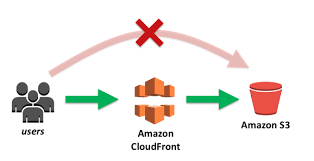Speeding Up Your Content Delivery with AWS CloudFront: A Blogger's Guide
 Sarvadnya Jawle
Sarvadnya Jawle
Ever scrolled through Instagram and experienced painfully slow loading times for pictures and videos? Frustrating, right? That's where Content Delivery Networks (CDNs) like AWS CloudFront come to the rescue!
Imagine a global network of super-fast servers strategically placed around the world. When you request content from a website using CloudFront, instead of going directly to the origin server (think Instagram's data center), your request gets routed to the closest edge server in the network. This edge server already has a cached copy of the content, delivering it to you in a blink. The result? Blazing-fast loading times and a smoother user experience.
But wait, there's more! CloudFront isn't just about speed. It also helps:
Reduce Costs: By caching content geographically, CloudFront minimizes data transfer from the origin server, translating to lower bandwidth costs.
Enhance Security: CloudFront offers features like secure protocols and DDoS protection, safeguarding your content from malicious attacks.
Improve Scalability: With a global network of servers, CloudFront can handle traffic surges gracefully, ensuring your website stays up and running even during peak usage.
So, how does CloudFront achieve these benefits?
Multiple Copies, Multiple Regions: CloudFront automatically stores copies of your content at various edge locations around the world. This way, your users always access the nearest copy, minimizing latency and reducing load on your origin server.
Intelligent Routing: CloudFront continuously monitors network conditions and user traffic patterns. It then intelligently routes each request to the edge server that can deliver the content most efficiently.
Security Features: CloudFront offers features like HTTPS support, access control lists, and AWS Shield for DDoS protection, adding an extra layer of security to your content delivery.
Setting Up CloudFront:
Creating a CloudFront distribution is surprisingly straightforward. You simply specify your origin server (e.g., your website hosted on Amazon S3) and configure your desired settings. CloudFront then takes care of managing the edge locations and routing requests.
Is CloudFront free?
No, it's a pay-as-you-go service. However, the cost is typically minimal, especially compared to the significant benefits you gain in terms of performance, security, and scalability. Think of it as an investment in a better user experience for your website visitors.
Real-Life Examples:
Instagram: As mentioned earlier, Instagram uses CloudFront to deliver its massive amount of photos and videos quickly and reliably to users worldwide.
Netflix: With millions of users streaming simultaneously, Netflix relies on CloudFront's global network to ensure smooth playback experiences regardless of location.
Airbnb: By using CloudFront, Airbnb can deliver its website and listing images quickly to users everywhere, helping them find their perfect vacation home faster.
Tips and Best Practices:
Utilize caching: Configure CloudFront to cache your static content effectively, minimizing origin server load and improving performance.
Optimize file sizes: Smaller file sizes mean faster delivery speeds and lower costs.
Monitor and adjust: Keep an eye on your CloudFront usage and adjust your settings if needed to optimize performance and costs.
Summary:
In today's fast-paced online world, speed and reliability are crucial for any website's success. AWS CloudFront provides a powerful and cost-effective solution to deliver your content quickly and securely to users around the globe. So, don't let slow loading times and high costs hold you back. Give CloudFront a try and experience the difference it can make for your website and your users!
Subscribe to my newsletter
Read articles from Sarvadnya Jawle directly inside your inbox. Subscribe to the newsletter, and don't miss out.
Written by

Sarvadnya Jawle
Sarvadnya Jawle
I am DevOps enthusiastic person. I work on Docker, Kubernetes and Open source. talks about cloud native tools.